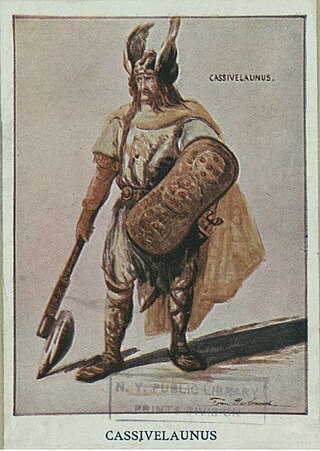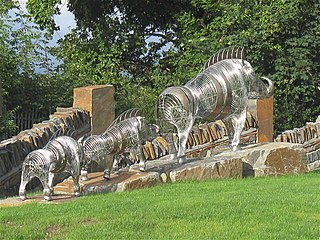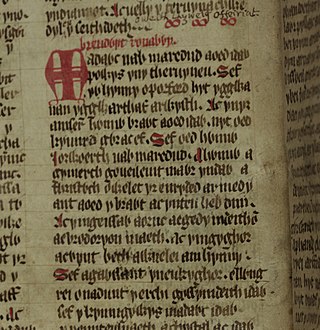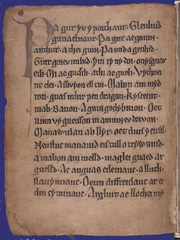Related Research Articles

Brân the Blessed is a giant and king of Britain in Welsh mythology. He appears in several of the Welsh Triads, but his most significant role is in the Second Branch of the Mabinogi, Branwen ferch Llŷr. He is a son of Llŷr and Penarddun, and the brother of Brânwen, Manawydan, Nisien and Efnysien. The name "Brân" in Welsh is usually translated as crow or raven.

The Mabinogion are the earliest Welsh prose stories, and belong to the Matter of Britain. The stories were compiled in Middle Welsh in the 12th–13th centuries from earlier oral traditions. There are two main source manuscripts, created c. 1350–1410, as well as a few earlier fragments. The title covers a collection of eleven prose stories of widely different types, offering drama, philosophy, romance, tragedy, fantasy and humour, and created by various narrators over time. There is a classic hero quest, "Culhwch and Olwen"; a historic legend in "Lludd and Llefelys", complete with glimpses of a far off age; and other tales portray a very different King Arthur from the later popular versions. The highly sophisticated complexity of the Four Branches of the Mabinogi defies categorisation. The stories are so diverse that it has been argued that they are not even a true collection.
Aneirin, also rendered as Aneurin or Neirin and Aneurin Gwawdrydd, was an early Medieval Brythonic war poet who lived during the 6th century. He is believed to have been a bard or court poet in one of the Cumbric kingdoms of the Hen Ogledd, probably that of Gododdin at Edinburgh, in modern Scotland. From the 17th century, he was usually known as Aneurin.

Cassivellaunus was a historical British military leader who led the defence against Julius Caesar's second expedition to Britain in 54 BC. He led an alliance of tribes against Roman forces, but eventually surrendered after his location was revealed to Julius Caesar by defeated Britons.

The Red Book of Hergest, Oxford, Jesus College, MS 111, is a large vellum manuscript written shortly after 1382, which ranks as one of the most important medieval manuscripts written in the Welsh language. It preserves a collection of Welsh prose and poetry, notably the tales of the Mabinogion and Gogynfeirdd poetry. The manuscript derives its name from the colour of its leather binding and from its association with Hergest Court between the late 15th and early 17th century.

The Welsh Triads are a group of related texts in medieval manuscripts which preserve fragments of Welsh folklore, mythology and traditional history in groups of three. The triad is a rhetorical form whereby objects are grouped together in threes, with a heading indicating the point of likeness; for example, "Three things not easily restrained, the flow of a torrent, the flight of an arrow, and the tongue of a fool."
Rhun ap Maelgwn Gwynedd, also known as Rhun Hir ap Maelgwn Gwynedd, sometimes spelt as 'Rhûn', was King of Gwynedd. He came to the throne on the death of his father, King Maelgwn Gwynedd. There are no historical records of his reign in this early age. A story preserved in both the Venedotian Code and an elegy by Taliesin says that he waged a war against Rhydderch Hael of Alt Clut and the kings of Gododdin or Manaw Gododdin. The small scattered settlement of Caerhun in the Conwy valley is said to be named for him, though without strong authority. Rhun also appears in several medieval literary stories, as well as in the Welsh Triads. His wife was Perwyr ferch Rhûn "Ryfeddfawr" and their son was Beli ap Rhun "Hîr".

Twrch Trwyth, is a fabulous wild boar from the Legend of King Arthur, of which a richly elaborate account of its hunt described in the Welsh prose romance Culhwch and Olwen, probably written around 1100.

Cath Palug was a monstrous cat in Welsh mythology associated with Arthurian legend. Given birth to in Gwynedd by the pig Henwen of Cornwall, the cat was to haunt the Isle of Anglesey until Kay went to the island to hunt it down. Outside of Wales, the cat's opponent has been transposed to King Arthur himself or, occasionally, other legendary heroes such as Ogier the Dane. Cath Palug's name in French literature is Chapalu.
The Battle of Arfderydd was fought in medieval Britain in AD 573, according to the Annales Cambriae. The opposing armies are identified in a number of Old Welsh sources but vary between them, perhaps suggesting several allied armies were involved. The main adversaries appear to have been Gwenddoleu ap Ceidio and either the princely brothers Peredur and Gwrgi or King Rhydderch Hael of Strathclyde. Gwenddoleu was defeated and killed in the battle. His bard, Myrddin Wyllt, reportedly went mad and ran into the forest. He is one of several proposed origins for the Arthurian character Merlin. The Welsh Triads refer to this battle as one of the "Three Futile Battles of the Island of Britain", along with the Battle of Camlann and the Battle of the Trees.
The Four Branches of the Mabinogi or Pedair Cainc Y Mabinogi are the earliest prose stories in the literature of Britain. Originally written in Wales in Middle Welsh, but widely available in translations, the Mabinogi is generally agreed to be a single work in four parts, or "branches." The interrelated tales can be read as mythology, political themes, romances, or magical fantasies. They appeal to a wide range of readers, from young children to the most sophisticated adult. The tales are popular today in book format, as storytelling or theatre performances; they appear in recordings and on film, and continue to inspire many reinterpretations in artwork and modern fiction.

Peredur son of Efrawg is one of the Three Welsh Romances associated with the Mabinogion. It tells a story roughly analogous to Chrétien de Troyes' unfinished romance Perceval, the Story of the Grail, but it contains many striking differences from that work, most notably the absence of the French poem's central object, the grail.
Sanddef Pryd Angel is a figure of Welsh tradition. He usually figures as a warrior of King Arthur's court, and is distinguished by his great beauty, which gives him his epithet Pryd or Bryd Angel.

The Dream of Rhonabwy is a Middle Welsh prose tale. Set during the reign of Madog ap Maredudd, prince of Powys, its composition is typically dated to somewhere between the late 12th through the late 14th century. It survives in only one manuscript, the Red Book of Hergest, and has been associated with the Mabinogion since its publication by Lady Charlotte Guest in the 19th century. A diplomatic version of the text is published by the University of Wales Press as Breuddwyt Ronabwy, edited by Grafton Melville Richards, first published in 1948. The bulk of the narrative describes a dream vision experienced by its central character, Rhonabwy, a retainer of Madog, in which he visits the time of King Arthur. The text seems to use the fictional trope of time travel.
The Coraniaid are a race of beings from Welsh mythology. They appear in the Middle Welsh prose tale Lludd and Llefelys, which survives in the Mabinogion and inserted into several texts of the Brut y Brenhinedd, a Welsh adaptation of Geoffrey of Monmouth's Historia Regum Britanniae. The Coraniaid figure in the tale as one of three plagues that affect Britain during the reign of King Lludd. They are characterized by a sense of hearing so acute that they can hear any word the wind touches, making action against them impossible.

Lludd and Llefelys is a Middle Welsh prose tale written down in the 12th or 13th century; it was included in the Mabinogion by Lady Charlotte Guest in the 19th century. It tells of the Welsh hero Lludd Llaw Eraint, best known as King Lud son of Heli in Geoffrey of Monmouth's Historia Regum Britanniae, and his brother Llefelys.

Manawydan fab Llŷr; "Manawydan, the son of Llŷr" is a legendary tale from medieval Welsh literature and the third of the four branches of the Mabinogi. It is a direct sequel to the second branch, Branwen ferch Llŷr, and deals with the aftermath of Bran's invasion of Ireland and the horrific enchantment that transforms Dyfed into a wasteland. The chief characters of the tale are Manawydan, rightful king of Britain, his friend Pryderi, the king of Dyfed and their respective wives Rhiannon and Cigfa. Along with the other branches, the tale can be found the medieval Red Book of Hergest and White Book of Rhydderch. Allusions to the tale can be found in two old triads retained in the Trioedd Ynys Prydein.
Cavall was King Arthur's dog, used in the hunt for the great boar, Twrch Trwyth.
Ysgithyrwyn Chief Boar, Yskithyrwyn Benbaedd or "White-tusk chief of Boars" is another boar being hunted, secondary to the great boar Twrch Trwyth by the Arthur's wild chase party in the Welsh Arthurian romance Culhwch ac Olwen.

Poem 31 of the Black Book of Carmarthen, a mid-13th century manuscript, is known from its first line as Pa gur yv y porthaur? or Pa gur, or alternatively as Ymddiddan Arthur a Glewlwyd Gafaelfawr. It is a fragmentary, anonymous poem in Old Welsh, taking the form of a dialogue between King Arthur and the gatekeeper Glewlwyd Gafaelfawr, in which Arthur boasts of his own exploits and those of his companions, especially Cai the Fair. Pa gur is notable for being one of the earliest vernacular Arthurian works, and for alluding to several early adventures of Arthur which are now lost. Its precise age is not known and has been the subject of wide-ranging disagreement, but scholarly opinion now tends to favour a date of c. 1100.
References
(Triads)
- Bromwich, Rachel (1961), Trioedd Ynys Prydein: The Welsh Triads (snippet), Cardiff: University of Wales Press
- Guest, Charlotte, Lady (1849), The Mabinogion : from the Llyfr coch o Hergest (Google), vol. 2, London: Longman, Brown, Green, and Longmans
{{citation}}: CS1 maint: multiple names: authors list (link) - Guest, Charlotte, Lady (1877), "The Mabinogion : from the Welsh of the Llyfr coch o Hergest (The red book of Hergest) in the Library of Jesus College, Oxford" (Google), _, London: Quaritch
{{citation}}: CS1 maint: multiple names: authors list (link) - Skene, William Forbes (1868), The Four Ancient Books of Wales (Google), vol. 2, Edinburgh: Edmonston and Douglas Triads re Arthur p. 457-,Canu y Meirch (Book of Taliesin XXV) p. 175-7 (text) and Vol. 1, p.307- (translation)